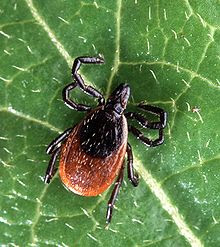 |
| Microscopic Tick |
What is babesiosis and how will this dribble effect my life, you ask? Let's discuss the origins and implications.
Babesiosis is usually transmitted by deer ticks. Babesia microti ares the causative organism in Lyme disease and obviously Babesiosis. The actual infection is not unlike Malaria, so it's pretty great. By great, I mean potentially devastating. At first, it feels like the flu. Then, hooray! Acute organ failure.
I figured I'd take the alarmist stance to get your attention. I know you're probably here to learn how to kill ticks, but we've plenty of time for that later; besides, I like to keep you guessing. Now, for the straight dope. Healthy adults have little to fear from this illness. Unless you have an immunodeficiency, Babesiosis is probably going to resolve itself if you manage to contract it, which is difficult given its propensity to be geo-specific. So, put you fears aside. Now back to the troubling part; Babesiosis is in the blood supply. Or is it troubling? Actually, it's not. It turns out this is less epidemic and more advancement in medical diagnosis. That's right, there probably aren't more instances of Babesiosis in the blood supply, doctors are just getting better at identifying it.

